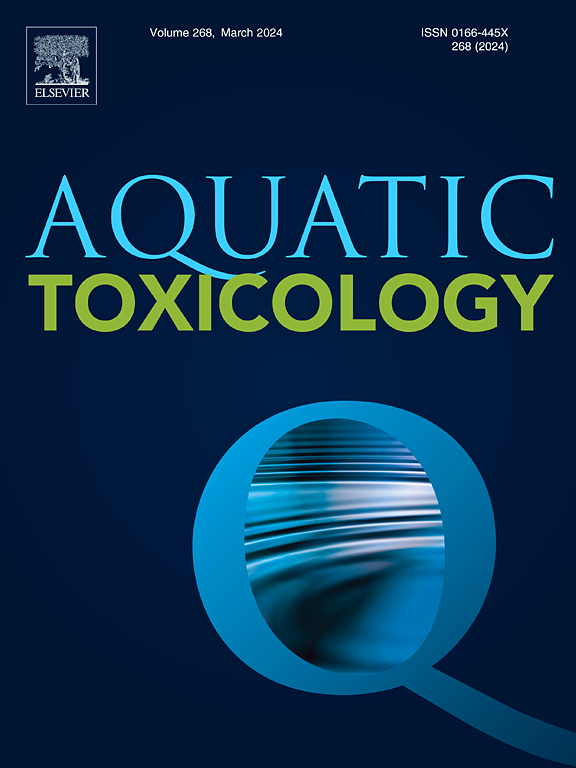长期接触地屈孕酮对斑马鱼肝脏代谢的性别特异性影响
IF 4.1
2区 环境科学与生态学
Q1 MARINE & FRESHWATER BIOLOGY
引用次数: 0
摘要
合成黄体酮地屈孕酮广泛应用于妇科和畜牧业,环境检出率和浓度较高。地屈孕酮影响鱼类的性别分化、性腺发育和产卵。然而,它对肝脏的影响,一个重要的器官激素生产和解毒,仍然是未知的。在这项研究中,斑马鱼胚胎分别暴露于2.8、27.6和289.8 ng/L的地孕酮中,直到它们达到性成熟。利用代谢组学和傅里叶变换红外光谱(FTIR)研究斑马鱼肝脏的变化。长期接触地屈孕酮会使雌性体重和体长减少,而雄性体重和体长则增加。磷脂、单甘油三酯、溶血磷脂、脂肪酸、酰基肉碱、酰基牛磺酸、胆固醇和胆汁酸的水平在女性肝脏中升高,而在男性肝脏中由于地屈孕酮的作用而降低,代谢途径受到的影响最大。FTIR分析显示,暴露的男性肝脏中脂质和蛋白质吸收减少,同时碳水化合物吸收增加,而暴露的女性肝脏中脂质和碳水化合物吸收减少。这些发现表明,长期接触地屈孕酮可以促进雄性斑马鱼的基本代谢和身体生长。据我们所知,这是关于黄体酮对身体代谢影响的第一份报告。此外,我们发现性别差异是地屈孕酮对斑马鱼的影响的显著特征。本文章由计算机程序翻译,如有差异,请以英文原文为准。
Gender-specific effects of dydrogesterone on zebrafish liver metabolism after long-term exposure
Synthetic progestin dydrogesterone is widely used in gynecology and animal husbandry, leading to high environmental detection rates and concentrations. Dydrogesterone influences sex differentiation, gonad development, and spawning in fish. However, its impact on the liver, a vital organ for hormone production and detoxification, remains largely unknown. In this study, zebrafish embryos were exposed to 2.8, 27.6, and 289.8 ng/L of dydrogesterone until they reached sexual maturity. Metabolomics and Fourier transform infrared spectroscopy (FTIR) were employed to investigate alterations in the zebrafish liver. Long-term exposure to dydrogesterone decreased body weight and length in females but increased them in males. The levels of phospholipids, monoglycerides, lysophospholipids, fatty acids, acylcarnitines, acyltaurines, cholesterol, and bile acids increased in the liver of females but decreased in males due to dydrogesterone, making the metabolic pathways the most affected. FTIR analysis revealed a reduction in lipid and protein absorption coupled with an increase in carbohydrate absorption in the liver of exposed males, whereas exposed females exhibited reductions in both lipid and carbohydrate absorption. These findings suggest that long-term exposure to dydrogesterone enhances basic metabolism and physical growth in male zebrafish. To the best of our knowledge, this is the first report on the effects of progestins on body metabolism. Additionally, we find that gender difference is a notable feature of the effects of dydrogesterone on zebrafish.
求助全文
通过发布文献求助,成功后即可免费获取论文全文。
去求助
来源期刊

Aquatic Toxicology
环境科学-毒理学
CiteScore
7.10
自引率
4.40%
发文量
250
审稿时长
56 days
期刊介绍:
Aquatic Toxicology publishes significant contributions that increase the understanding of the impact of harmful substances (including natural and synthetic chemicals) on aquatic organisms and ecosystems.
Aquatic Toxicology considers both laboratory and field studies with a focus on marine/ freshwater environments. We strive to attract high quality original scientific papers, critical reviews and expert opinion papers in the following areas: Effects of harmful substances on molecular, cellular, sub-organismal, organismal, population, community, and ecosystem level; Toxic Mechanisms; Genetic disturbances, transgenerational effects, behavioral and adaptive responses; Impacts of harmful substances on structure, function of and services provided by aquatic ecosystems; Mixture toxicity assessment; Statistical approaches to predict exposure to and hazards of contaminants
The journal also considers manuscripts in other areas, such as the development of innovative concepts, approaches, and methodologies, which promote the wider application of toxicological datasets to the protection of aquatic environments and inform ecological risk assessments and decision making by relevant authorities.
 求助内容:
求助内容: 应助结果提醒方式:
应助结果提醒方式:


